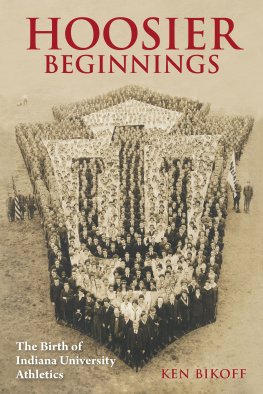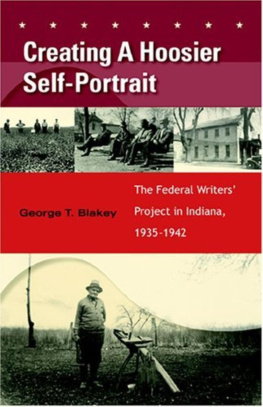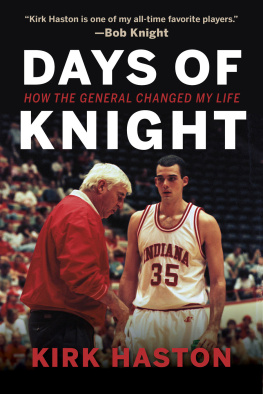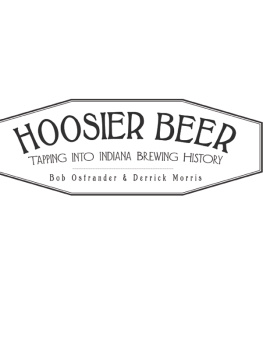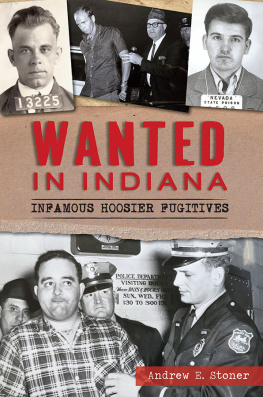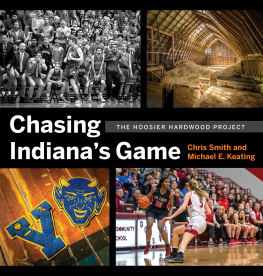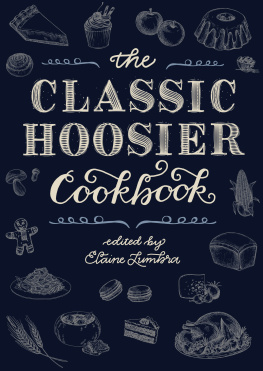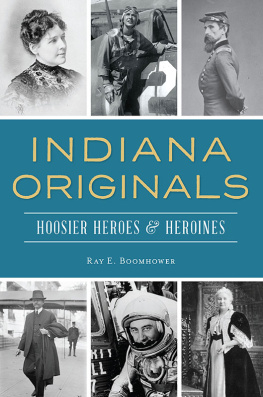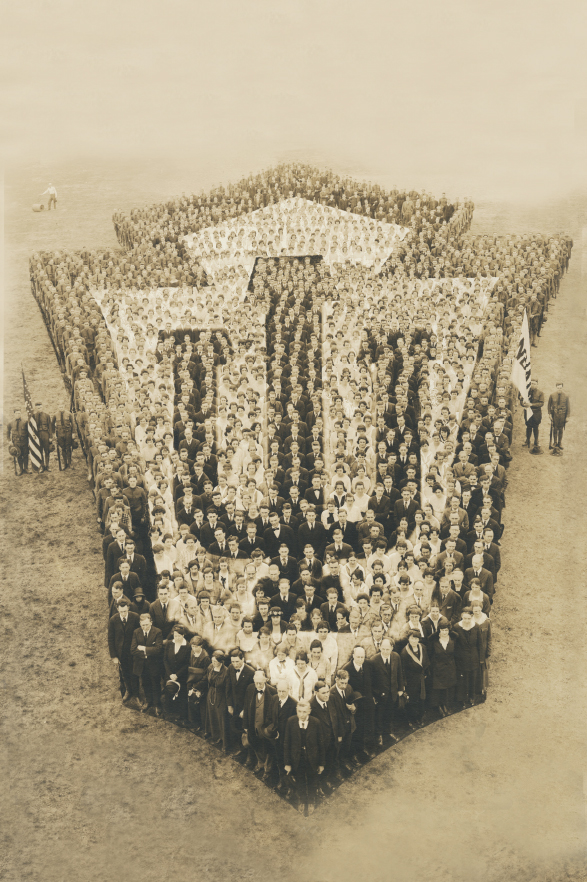
HOOSIER
BEGINNINGS
HOOSIER
BEGINNINGS
The Birth of Indiana University Athletics
KEN BIKOFF
This book is a publication of
Indiana University Press
Office of Scholarly Publishing
Herman B Wells Library 350
1320 East 10th Street
Bloomington, Indiana 47405 USA
iupress.org
2020 by Indiana University Press
All rights reserved
No part of this book may be reproduced or utilized in any form or by any means, electronic or mechanical, including photocopying and recording, or by any information storage and retrieval system, without permission in writing from the publisher. The paper used in this publication meets the minimum requirements of the American National Standard for Information SciencesPermanence of Paper for Printed Library Materials, ANSI Z39.481992.
Manufactured in the United States of America
Cataloging information is available from the Library of Congress.
ISBN 978-0-253-05047-2 (cloth)
ISBN 978-0-253-05048-9 (paper)
ISBN 978-0-253-05049-6 (ebook)
First printing 2020
To Nick and Charlie
NOTHING NEW EVER HAPPENS, BUT YOU CAN BE UNIQUE. GO MAKE HISTORY.
Contents
Preface
Im surrounded by ghosts. I always have been.
I havent always seen them, but theyve always been there. They arent rattling chains or knocking on floors at all hours of the night. I dont need to call Bill Murray and his friends to come bust anything. But everywhere I look, there are ghosts.
Theyre around you, too.
Thats what history is to me. Real ghosts. I can walk down Tenth Street on the campus of Indiana University toward the Herman B Wells Library, and I dont just see Woodlawn Field and some intramural soccer goals. I dont just see the Arboretum. I dont just see what used to be known as the HPER when I was a student in Bloomington from 1993 to 1997.
Instead, I see the golf course that used to be in the area of the Arboretum and Woodlawn Field back when all of it was called Dunn Meadow. Dunn Meadow still exists, of course, as a far smaller area in front of the Indiana Memorial Union, and they used to play tennis there but I digress.
The ghosts get in the way all the time.
Back on Tenth Street, I see the original Memorial Stadium where the Arboretum stands. I can look at the HPER building and imagine an apple orchard blocking my view of the landscape, and I can nearly hear the sound of axes chopping down trees to reshape the campus.
I can walk past Ernie Pyle Hall, where I spent so many hours as an undergrad pursuing my degree from the then School of Journalism, and I dont just see a parking lot outside of the Union. I see Jordan Field and imagine Jim Thorpe and Jimmy Sheldon and Cotton Berndt setting the foundation for football at the university.
I can walk behind the union and see the carpenters shop that was the original gymnasium, where the first practices for IU basketball were held. I can walk through a parking lot where the original Assembly Hall stood, and I can read a marker that tells the story of what used to be therea marker I had a part in getting placed on campus.
The ghosts are there. You just have to know to look for them.
Im consistently frustrated by history, too.
I wish so desperately that I could have watched a game at Jordan Field, that I could have cheered on IU at the original Assembly Hall, that I could have seen the buildings on the Seminary Square campus. They are all still real to me, and although they no longer exist, I feel a compulsion to keep them alive.
People love history. They really do. They just dont tend to like it the way it was taught to them in school.
Dates arent history, no matter what your lazy history teacher told you when you were in class just trying to stay awake. In the who-what-when-where-why-how equation, the when might be the least important part. Its a factnothing more, nothing less.
Memorizing facts isnt history. Its trivia. History is a story. Its right there in the word.
History explains the world. It explains the chain of events that leads people to lay out their hard-earned money for tickets, put on candy-striped pants, drive to a midwestern university, and walk into a building built solely for the purpose of hosting people to watch a silly childrens game in which someone throws a ball through a ring of iron.
History informs us where weve been and provides a guide for what may come. History predicts the future if you read it right, if you care enough to make the effort.
Ultimately, nothing new ever happens. Ever.
The biggest reason I consistently find myself frustrated by history is that so many people seem to think the world began the day they were born. Millions of students have walked by the Arboretum, never realizing Memorial Stadium once stood there. It doesnt cross their mind to wonder what the campus looked like ten or fifty or one hundred years earlier. They dont think twice about those who have taken those same steps before them, whether it was a day earlier, a month earlier, a year earlier, or a century earlier.
Yet each one of those ghosts led those students to the IU campus, sometimes literally. A chance meeting on band day at an IU football game may have led to a students grandparents meeting, and their shared love of IU and each other set into motion a chain of events that led to a student walking down Tenth Street on his or her way to class.
The seed of this book was planted in the late 2000s when I was working as editor-in-chief of Inside Indiana Magazine. I was strolling through a bookstore and flipped through a copy of the Bloomington and Indiana University edition of the Images of America series of books. Its essentially a history of an area told mostly through pictures.
There on one of the pages was a photo of the Faris family farm. The caption read, The Faris house and farm occupied the site until 1956, when these photographs were taken and the site was purchased by Indiana University. The Seventeenth Street Football Stadium was completed here in 1960. In 1971, it was renamed Memorial Stadium. Assembly Hall is located nearby on the east side of the site.
Later that same day, I called my boss, the late, great publisher of Inside Indiana, Ed Magoni, and told him I wanted to do a story about the history of the athletic facilities at IU. He thought it sounded like a good idea.
It will be just one story, I said.
I was wrong.
Over the next year, I put together a thirteen-part series on the history of every major athletic facility on IUs campus. The games that were played were a footnote. I was focused on how the facilities came to be.
That blossomed into a number of other history stories, leading me down a rabbit hole I hope I never escape. Youll read some of the stories in this book.
In May 2017, I was invited to speak to the Bloomington Rotary Club to tell some of my stories. I called the presentation A Short, Unorganized History of IU Athletics.
Following my first presentation, I was approached by someone asking if I had ever thought about putting together a book of the stories. It had crossed my mind, but I didnt have the slightest idea about how to go about getting a book published.
Next page
